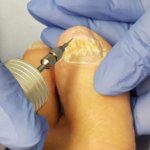Fungal nail infections – the facts
Embarrasing feet?
“You won’t have seen feet as bad as mine!” This is a comment I often hear before patients take off their socks and shoes but the truth is, after 20 + years in clinical practice, I probably have and there is little that can shock me these days!
People are often very self-conscious about their feet and embarrassed to get them out in the open. One of the pleasures of my job is reassuring them that their feet really aren’t that bad, and then getting them on a treatment programme to make them feel and look better.
What causes a fungal nail infection?
Fungal nail infections are a common cause of embarassment. This unsightly thickening and discolouration of the nails is caused by microscopic fungal spores which get underneath the nails and infect the nail bed underneath, disrupting the proper growth of the nail and causing chaos as they move further up the nail bed, infecting more and more of the nail as they go. They are the very same fungal spores that cause Athletes foot, and one can easily lead to the other.
While usually the seal between the nail and the nail bed prevents infection from occurring, it is all too easy for repetitive trauma from footwear to break the seal between nail and nail bed, and that is all the excuse the fungus needs to get stuck in.
Once established under the nail, it is difficult to treat as any anti-fungal medication put onto the nail is unable to penetrate the hard nail plate and reach the nail bed where the infection is.
What is the best treatment for fungal nail infection?
Oral prescription medications such as Terbinafine are available on prescription which attack the fungal infection systemically and are very effective. Whilst they are quite safe, people are often reluctant to take oral medication because of the listed side effects.

If this is the case, then an equally effective option is to make tiny holes in the nail plate so that anti-fungal medication can be introduced onto the nail bed via a spray dispenser; a technique called fenustration. This simple and elegant solution clears the fungus in the majority of cases and is a technique we use with great success at Active. The treatment is not painful and is risk free, often leading to an improvement in the appearance of the nail after a course of treatment. Find out more about this treatment here.
How can I prevent fungal nail infections?
The solution is good foot hygiene, making sure the skin and nails of your feet are healthy to prevent those fungal spores from getting a foothold (sorry). Here are my top 3 tips to keep your nails healthy and fungus free.
- Don’t cut your nails too short. Cutting toe nails too short can expose the nail bed and increase the risk of infection
- Don’t let your nails get too long!. Too long toenails can catch inside the shoes, lifting the nail and exposing the nail bed to infection.
- Keep your skin healthy. Dry cracked skin and soggy toe spaces due to poor drying can increase the risk of athletes foot, which can spread to the nails. Moisturise your skin with a Urea based foot cream every day, and dry carefully in between your toes.
Finally, beware off the Woo woo. People are understandably desparate to get rid of these nasty infections, and a whole industry of poorly researched products has sprung up to meet this demand. Many of these are ineffective, and you are best off talking to us first before spending your money. We are the experts in foot health and can give you the most up to date, evidence-based advice to help you get the best results in keeping your feet fungus free.

 Active Podiatry - Podiatry in Kent for Runners & Active People
Active Podiatry - Podiatry in Kent for Runners & Active People
Thank you for the information on cutting toenails. Very helpful.
Regarding ingrown toenails – what causes this to happen and what is the proper way to cut the nail to relieve the pain? (I’ve recently started getting an ingrown big toe and I cut the nail away until it’s clear of the skin.
Hi there, thanks for your feedback. There are many causes of ingrown toe nail but essentially the cause is a part of the nail irritating the skin, either by cutting the nail too far back, trauma or thickening of the nail. If you are getting a painful ingrown toe nail I suggest you consult a Podiatrist who can examine your toe and suggest the best management plan.